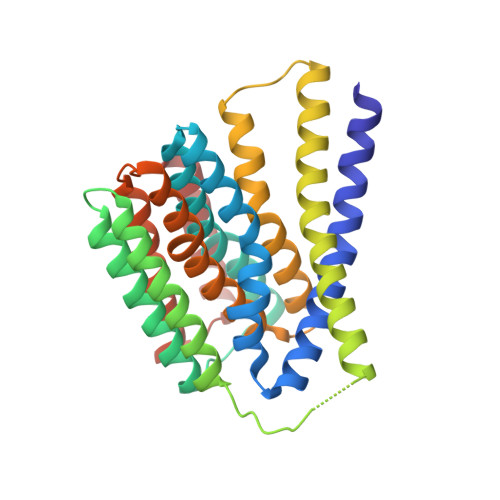Mechanism of extracellular ion exchange and binding-site occlusion in a sodium/calcium exchanger
Liao, J., Marinelli, F., Lee, C., Huang, Y., Faraldo-Gomez, J.D., Jiang, Y.(2016) Nat Struct Mol Biol 23: 590-599
- PubMed: 27183196
- DOI: https://doi.org/10.1038/nsmb.3230
- Primary Citation of Related Structures:
5HWX, 5HWY, 5HXC, 5HXE, 5HXH, 5HXR, 5HXS, 5HYA, 5JDF, 5JDG, 5JDH, 5JDL, 5JDM, 5JDN, 5JDQ - PubMed Abstract:
Na(+)/Ca(2+) exchangers use the Na(+) electrochemical gradient across the plasma membrane to extrude intracellular Ca(2+) and play a central role in Ca(2+) homeostasis. Here, we elucidate their mechanisms of extracellular ion recognition and exchange through a structural analysis of the exchanger from Methanococcus jannaschii (NCX_Mj) bound to Na(+), Ca(2+) or Sr(2+) in various occupancies and in an apo state. This analysis defines the binding mode and relative affinity of these ions, establishes the structural basis for the anticipated 3:1 Na(+)/Ca(2+)-exchange stoichiometry and reveals the conformational changes at the onset of the alternating-access transport mechanism. An independent analysis of the dynamics and conformational free-energy landscape of NCX_Mj in different ion-occupancy states, based on enhanced-sampling molecular dynamics simulations, demonstrates that the crystal structures reflect mechanistically relevant, interconverting conformations. These calculations also reveal the mechanism by which the outward-to-inward transition is controlled by the ion occupancy, thereby explaining the emergence of strictly coupled Na(+)/Ca(2+) antiport.
- School of Life Science and Technology, ShanghaiTech University, Shanghai, P.R. China.
Organizational Affiliation:




















